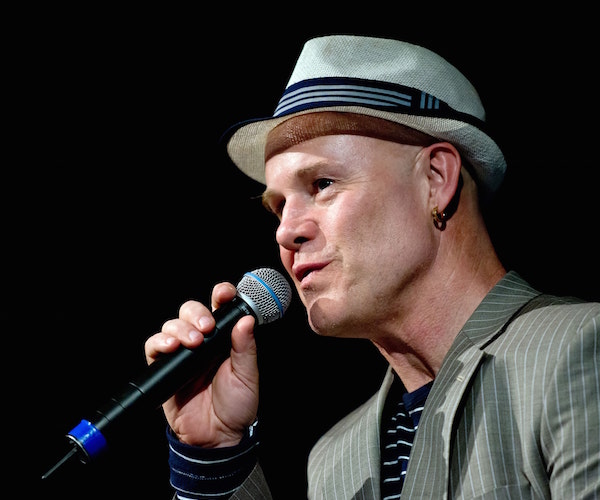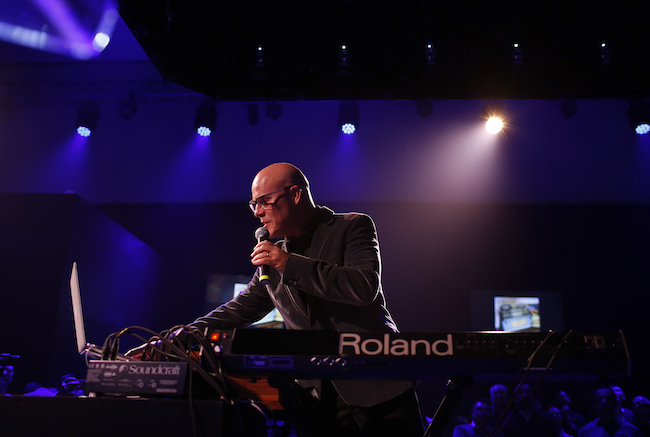Music Interview: Thomas Dolby — Music, Entrepreneurship, and Academia
“Rather than encourage the machines to behave like machines, I chose to find ways to sort of use them to create a very cinematic and atmospheric soundscapes.”

Thomas Dolby — “I was embarrassed that now I was the guy people would blame for the global ringtone plague.” Photo: courtesy of the artist.
By Blake Maddux
Although he will be forever remembered in the collective conscience for the unforgettable early-1980s radio hits and MTV videos “She Blinded Me with Science” and “Hyperactive,” Thomas Dolby (born Thomas Robertson) has a résumé includes countless endeavors in music, entrepreneurship, and academia.
The solo career that he began in 1982 led to live and studio collaborations with Stevie Wonder, Herbie Hancock, David Bowie, George Clinton, Roger Waters, Eddie Van Halen, and Jerry Garcia and Bob Weir of The Grateful Dead. Dolby’s producer credits include works by Whodini, Prefab Sprout, and Joni Mitchell. Furthermore, he played keyboards and synthesizer on multi-platinum albums by Foreigner (4) and Def Leppard (Pyromania).
Dolby’s music career was displaced in the ’90s by his venture into Silicon Valley, where he helped create the technology that made ringtones—including “the Nokia Waltz”—possible. He wrote of this achievement in his 2016 memoir, The Speed of Sound: Breaking the Barriers Between Music and Technology, “I was embarrassed that now I was the guy people would blame for the global ringtone plague.”
After serving from 2001 to 2012 as the musical director for the TED Conference, Dolby accepted a professorship at Johns Hopkins University in 2014. He will administer the university’s brand new four-year Bachelor of Music program called Music for New Media starting this fall.
In the meantime, he is going on a short summer tour called “An Evening of Music and Storytelling” in support of the new two-disc compilation, Hyperactive, which is set to be released on July 27. He spoke to The Arts Fuse by phone from the English countryside ahead of his August 4 performance at The Center for the Arts in Natick.

The Arts Fuse: From what I’ve read about this tour, there is no given setlist for each night. Rather, songs will be selected by the audience.
Thomas Dolby: Yeah, that’s exactly right. I’m gonna go into a lot more depth with each song than I normally would. I want to make it different every night, so the audience will make the selection and then I will cover maybe half a dozen songs during the course of the evening but in great depth. So I’ll be talking about what inspired the song, how I put the lyrics together, chord sequence, the beat, some of the sounds that I chose, maybe some anecdotes related to how I recorded it or places that I played it or comments that people have made to me about the song or whatever. I’m really gonna sort of, you know, decompress each song.
AF: Will audience members pick a number? Spin a wheel? Submit requests in writing?
TD: I have to keep that as a surprise, because I don’t want anybody sort of preempting it and figuring out the method in advance and sort of scamming me! (laughs)
AF: How much variation do you expect from show to show?
TD: It will vary every night, so in some places the consensus may be play the better-known songs, like “She Blinded Me with Science” and “Hyperactive” and “Europa and the Pirate Twins.” In others, they may go for the deeper cuts, you know, because the songs of mine that people feel most strongly about tend not to be the radio hits. They tend to be songs like “I Love You Goodbye” or “Screen Kiss” or “Airwaves,” “Budapest By Blimp.” You know, the sort of deeper album cuts.
AF: What do you feel were your contributions to the charting of its course of synth-pop in the 1980s?
TD: Well, I think it was quite unusual in many ways, because as synthesizers and electronics became more prevalent in pop music, many of my contemporaries tended to sort of use them to exaggerate the coldness and machine-like qualities of electronic instruments. Which is, you know, a perfectly valid thing to do. But I what I chose to do with them, actually, was to sort of explore some more, you know, lush and sort of symphonic timbres … I was very much a DIY musician, so I tended to use those instruments to try and assimilate a much lusher instrumentation. So I think that probably was my contribution. Rather than encourage the machines to behave like machines, I chose to find ways to sort of use them to create a very cinematic and atmospheric soundscapes.
AF: How much credit do you think that you deserve for your contribution to the burgeoning hip-hop genre by your having worked on Whodini’s 1982 single “Magic’s Wand”?
TD: Although “Magic’s Wand” was actually the first platinum-selling rap 12-inch ever in the Billboard charts and it got me in the Hip-Hop Hall of Fame, it’s pretty much unwarranted because I was in London programming a Fairlight and the vocals were put on in New York and I’ve never even met the guys. My beats were sent over on floppy disks to New York and loaded into a Fairlight there and they added a rap over the top. So I think my link is quite tenuous.
AF: In the videos for “She Blinded Me with Science” and “Hyperactive,” you portray a person who is receiving psychiatric treatment. Is there an autobiographical basis for this?
TD: I mean, I’ve never suffered from mental health issues myself, to the best of my knowledge. I think I was certainly, you know, quite a hyperactive kid and I sort of remained that way until I channeled my energy into music as a teenager. But no, I don’t think it’s particularly autobiographical.
AF: Was the tension between you and Joni Mitchell during the recording of her album Dog Eat Dog in 1985 a matter or creative differences, personal ones, or some of both?
TD: I think that what I would put it down to, really, was this. Joni has often worked with collaborators. She’s had periods of her work with people like Tom Scott and Jaco Pastorius that have been very iconic, where she’s really sort of had a mind-meld with a given musician … And when I got the opportunity to work with her—one of my ultimate heroes—my hope was that I would be the latest in that line of collaborators … I thought I’d hit the jackpot, because here was somebody who I adored musically who acknowledged that she needed some help in the studio and she seemed to respect and like my material enough that she was willing to give me that shot.
It didn’t really work out that way, and I think part of the issue was that we play the same instrument. So I’d be on the keyboard programming a sound that was designed for a four-note melody, and Joni would come over and budge me off the piano stool and say, “Oh, let me try,” and she’d start playing a piano part with two hands with that sound. And it really wouldn’t fit with the rest of what I’d done, so she’d say, “Oh, wipe those last six tracks,” and I’d go, “Whoa, whoa wait a minute! It’d taken us a day to do that…” And she’d say, “I love to burn my bridges. This is great. Let’s put it down….”
Unfortunately, we fell out towards the end I think largely because of anger that Joni had that was, you know, sort of misdirected. I mean, she had had a lot of things going off the rails in her life at the time and I became the butt end of that. Fans were not very keen on that album because it sounded different, and they needed someone to blame it on, and encouraged by Joni’s comments, they sort of pinned it on me, because obviously I was the difference.
AF: Do you have any interesting Boston-related tales from your personal or professional life?
TD: I remember Ric Ocasek coming to see me play at the Paradise, back in some prehistoric era, and being very complimentary, which was flattering to me because I was a big Cars fan in the early days. That would have been probably ’83-ish, I would think. I think probably after “She Blinded Me with Science” (1982) but before The Flat Earth (1984).

Thomas Dolby in action. Photo: courtesy of the artist.
AF: Why did you choose your performance at Berklee College of Music for the DVD recording of your 2006 Sole Inhabitant tour?
TD: Quite simple. They had a multi-camera set-up, they were planning to film it anyway for their archives, and I had already planned to release a DVD shot in the clubs where I was performing the show. And I thought, why not make it a double with two different performances? One a more controlled performance on the stage at Berklee, and the other a steamier, you know, kind of club version.
AF: Are you aware that the venue that you will be playing is in the town in which Jonathan Richman was born and raised?
TD: Oh really? Okay. That’s very interesting, ‘cause they [Richman’s band The Modern Lovers] just about predated the advent of punk in London. The legendary John Peel, who was a BBC late-night DJ, played stuff like Jonathan Richman. Was it “Roadrunner”? Was that the name of it? He used to play that song in probably early ’76, you know, right before the arrival of the Sex Pistols and The Clash. That’s good to know!
Blake Maddux is a freelance journalist who also contributes to The Somerville Times, DigBoston, Lynn Happens, and various Wicked Local publications on the North Shore. In 2013, he received an MLA from Harvard Extension School, which awarded him the Dean’s Prize for Outstanding Thesis in Journalism. A native Ohioan, he moved to Boston in 2002 and currently lives with his wife in Salem, Massachusetts.
